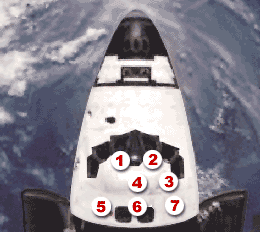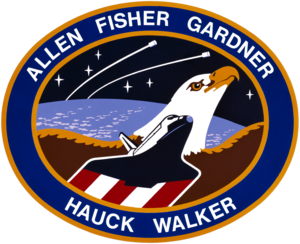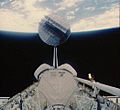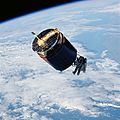STS-51-A facts for kids
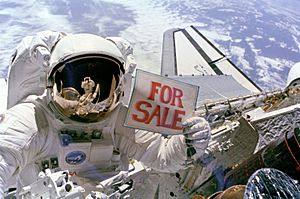
Dale A. Gardner poses in front of a camera with a "For Sale" sign in his hand, jokingly referring to the two broken satellites (Palapa B2 and Westar 6) the crew was sent out on EVA to pick up and return to Earth.
|
|
| Names | Space Transportation System-14 |
|---|---|
| Mission type | Communications satellites deployment Communications satellites retrieval |
| Operator | NASA |
| Mission duration | 7 days, 23 hours, 44 minutes, 56 seconds (achieved) |
| Distance travelled | 5,293,786 km (3,289,406 mi) |
| Orbits completed | 127 |
| Spacecraft properties | |
| Spacecraft | Space Shuttle Discovery |
| Launch mass | 119,442 kg (263,325 lb) |
| Landing mass | 94,123 kg (207,506 lb) |
| Payload mass | 17,375 kg (38,305 lb) |
| Crew | |
| Crew size | 5 |
| Members |
|
| EVAs | 2 |
| EVA duration | 11 hours, 42 minutes First: 6 hours, 0 minute Second: 5 hours, 42 minutes |
| Start of mission | |
| Launch date | 8 November 1984, 12:15:00 UTC |
| Rocket | Space Shuttle Discovery |
| Launch site | Kennedy Space Center, LC-39A |
| Contractor | Rockwell International |
| End of mission | |
| Landing date | 16 November 1984, 11:59:56 UTC |
| Landing site | Kennedy Space Center, SLF Runway 15 |
| Orbital parameters | |
| Reference system | Geocentric orbit |
| Regime | Low Earth orbit |
| Perigee | 332 km (206 mi) |
| Apogee | 354 km (220 mi) |
| Inclination | 28.45° |
| Period | 90.40 minutes |
 STS-51-A mission patch 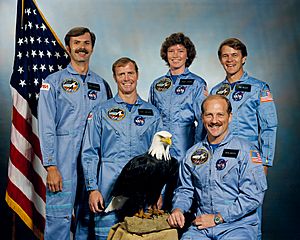 Dale A. Gardner, David M. Walker, Anna Lee Fisher, Frederick H. Hauck, Joseph P. Allen |
|
STS-51-A was the 14th flight of NASA's Space Shuttle program. It was the second journey for the Space Shuttle Discovery. The mission started from Kennedy Space Center on November 8, 1984. It landed almost eight days later on November 16, 1984.
This mission was special because it was the first time a space shuttle both launched two communications satellites and brought two broken ones back from space. The crew successfully sent out the Canadian Anik D2 and Syncom IV-1 satellites. They also rescued Palapa B2 and Westar 6. These two satellites had been launched earlier but got stuck in the wrong orbits. The astronauts safely brought them back to Earth.
Contents
Meet the Astronauts: STS-51-A Crew
The STS-51-A mission had a crew of five brave astronauts. They worked together to complete the mission's goals.
- Commander: Frederick H. Hauck (This was his second space flight.)
- Pilot: David M. Walker (This was his first time in space.)
- Mission Specialist 1: Joseph P. Allen (This was his second and last space flight.)
- Mission Specialist 2: Anna Lee Fisher (This was her only space flight.)
- Mission Specialist 3: Dale A. Gardner (This was his second and last space flight.)
Spacewalks: Working Outside the Shuttle
During the mission, two spacewalks, also known as Extravehicular Activities (EVAs), were performed. Astronauts Joseph P. Allen and Dale A. Gardner went outside the shuttle to fix and retrieve the broken satellites.
- Spacewalk 1:
- Astronauts: Allen and Gardner
- Start Time: November 12, 1984 – 1:25 PM UTC
- End Time: November 12, 1984 – 7:25 PM UTC
- Duration: 6 hours, 0 minute
- Spacewalk 2:
- Astronauts: Allen and Gardner
- Start Time: November 14, 1984 – 11:09 AM UTC
- End Time: November 14, 1984 – 4:51 PM UTC
- Duration: 5 hours, 42 minutes
Mission Highlights: What Happened in Space?
STS-51-A launched from Florida's Kennedy Space Center (KSC) on November 8, 1984. The launch was a day later than planned due to strong winds high up in the atmosphere.
This mission was the first time a Space Shuttle was commanded by an astronaut from the 1978 class of astronauts. Before this, only astronauts from the Apollo era had commanded shuttle flights.
Deploying New Satellites
The crew successfully launched two new communication satellites:
- Anik D2 was deployed on the second day of the mission.
- Syncom IV-1, also known as Leasat 1, was deployed on the third day.
Both of these satellites were built by a company called Hughes.
Rescuing Broken Satellites
After deploying the new satellites, Discovery began to chase after the two broken satellites, Palapa B2 and Westar 6. Ground control had lowered the orbits of these satellites to make them easier to catch.
On the fifth day, Discovery met up with Palapa B2. Astronauts Allen and Gardner went on a spacewalk. Allen used a special tool called a "Stinger" to grab the satellite. Gardner, who was at the end of the robotic arm (Canadarm), tried to pull it in. It was tricky, but Allen managed to guide the satellite into its storage spot with Gardner's help. Astronaut Anna Lee Fisher operated the Canadarm to assist them. This amazing rescue took two hours!
The next day, recovering Westar 6 was easier. Gardner used the same technique Allen had used. He easily grabbed the satellite and, with Allen's help, placed it safely in the shuttle's cargo bay. After this success, Gardner famously held up a "For Sale" sign. This was a funny way to show that the mission had successfully recovered the broken satellites. Interestingly, the Westar satellite was later sold to a company in Hong Kong.
Science Experiments on Board
The STS-51-A mission also carried a science experiment called Diffused Mixing of Organic Solutions (DMOS). This experiment studied how different chemicals mix in space. It was the first of many experiments sponsored by the company 3M. The experiment was successful, and the results helped 3M learn more about new materials. Another experiment on board measured radiation in space.
The End of Untethered Spacewalks
The satellite rescues on STS-51-A were the last spacewalks where astronauts floated freely without being attached to the shuttle. They used a special backpack called the Manned Maneuvering Unit (MMU) for these spacewalks. After this mission, all spacewalks by NASA and Russian astronauts required them to be tethered (attached) to their spacecraft for safety. A new system called SAFER was tested in 1994, which was a simpler way to help astronauts if they floated away.
Landing Back on Earth
The second mission of Discovery ended on November 16, 1984. It landed successfully on Runway 15 at Kennedy Space Center. The flight completed 127 orbits around Earth and lasted for 7 days, 23 hours, 44 minutes, and 56 seconds. This was the third time a space shuttle landed at KSC and the fifth and final shuttle mission of 1984. Footage of this landing was even used in a 1985 IMAX movie called The Dream is Alive.
STS-51-A Mission Patch
The STS-51-A mission patch shows the Space Shuttle Discovery flying towards Earth's orbit. It looks like a soaring eagle, which reminds us of America's history and traditions with its red and white stripes and blue background. The two satellites orbiting Earth in the background show how versatile the Space Shuttle is. The patch also specifically includes the two satellites that the mission was sent to retrieve, highlighting the main goal of this flight. The names of the five crew members are written in white letters around the blue border.
Wake-up Calls from Space
NASA started a fun tradition of playing music to astronauts to wake them up. This began during the Project Gemini missions and was first used to wake up the crew on Apollo 15. Each song is chosen carefully, often by the astronauts' families. The songs usually have a special meaning to an astronaut or relate to what they will be doing that day.
| Flight Day | Song | Artist/Composer |
|---|---|---|
| Day 2 | "Marine Corps Hymn" | |
| Day 3 | "Theme from For a Few Dollars More" | Ennio Morricone |
Images for kids
See also
 In Spanish: STS-51-A para niños
In Spanish: STS-51-A para niños


